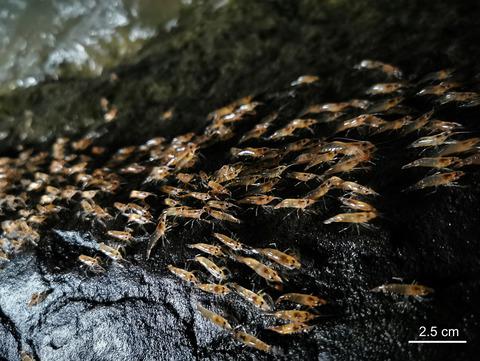Our official English website, www.x-mol.net, welcomes your feedback! (Note: you will need to create a separate account there.)
Why do shrimps leave the water? Mechanisms and functions of parading behaviour in freshwater shrimps
Journal of Zoology ( IF 2 ) Pub Date : 2020-11-09 , DOI: 10.1111/jzo.12841 W. Hongjamrassilp 1 , W. Maiphrom 2 , D. T. Blumstein 1
Journal of Zoology ( IF 2 ) Pub Date : 2020-11-09 , DOI: 10.1111/jzo.12841 W. Hongjamrassilp 1 , W. Maiphrom 2 , D. T. Blumstein 1
Affiliation

|
An understanding of the mechanisms and functions of animal migratory behaviour may provide insights into its evolution. Furthermore, knowledge about migration may be important for conservation of rare species and may help to manage species in a rapidly changing world. Upstream migration is common in riverine animals, but little is known about proximate cues and functions of the upstream migration in aquatic macroinvertebrates. In Ubon Ratchathani, Thailand, locals have observed a synchronous mass migration of freshwater shrimps on land. This so‐called ‘parading behaviour' occurs annually during the rainy season and has become a large ecotourism event. Yet, we know little about the natural history, proximate causation and function of this extraordinary behaviour. Here we describe the natural history of parading behaviour and report the results from a series of experiments and observations to address its mechanisms and functions. Parading behaviour is not associated with breeding and spawning; rather, shrimps leave the water to escape strong currents. Conditions promoting shrimps to leave the water include low light, high water velocity and low air temperature. In addition, there is variation explained the specific location. River topology that creates hydrological variability and turbulence plays a role in triggering the shrimps to move out of water. Furthermore, turbidity and water chemistry were associated with shrimp activity. Finally, our results support that parading behaviour in freshwater shrimps is a mass movement upstream due to hydrological displacement. This study highlights the mechanisms that stimulate parading behaviour; a common activity in Macrobrachium and other decapod crustaceans.
中文翻译:

虾为什么要离开水?淡水虾巡游行为的机制和功能
对动物迁徙行为的机制和功能的了解可能会为动物迁徙行为的发展提供见解。此外,有关迁徙的知识对于保护稀有物种可能很重要,并且可能有助于在瞬息万变的世界中管理物种。上游迁移在河沿动物中很常见,但对水生大型无脊椎动物近端线索和上游迁移功能的了解甚少。在泰国的乌汶市,当地人观察到陆地上的淡水虾同步大规模迁移。这种所谓的“游行行为”每年在雨季发生,已经成为一个大型的生态旅游事件。然而,我们对这种非常规行为的自然历史,近因和作用一无所知。在这里,我们描述了游行行为的自然历史,并报告了一系列实验和观察的结果,以探讨其机制和功能。游行行为与繁殖和产卵无关。相反,虾离开水流以逃避强流。促进虾离开水面的条件包括光线不足,水流速度高和空气温度低。此外,还有解释具体位置的变化。造成水文变化和湍流的河流拓扑结构在引发虾类移出水面方面发挥了作用。此外,浊度和水化学与虾的活动有关。最后,我们的结果支持淡水虾的巡游行为是由于水文位移而向上游的大规模运动。这项研究突出了刺激游行行为的机制。常见的活动沼虾和其他十足类甲壳动物。
更新日期:2020-11-09
中文翻译:

虾为什么要离开水?淡水虾巡游行为的机制和功能
对动物迁徙行为的机制和功能的了解可能会为动物迁徙行为的发展提供见解。此外,有关迁徙的知识对于保护稀有物种可能很重要,并且可能有助于在瞬息万变的世界中管理物种。上游迁移在河沿动物中很常见,但对水生大型无脊椎动物近端线索和上游迁移功能的了解甚少。在泰国的乌汶市,当地人观察到陆地上的淡水虾同步大规模迁移。这种所谓的“游行行为”每年在雨季发生,已经成为一个大型的生态旅游事件。然而,我们对这种非常规行为的自然历史,近因和作用一无所知。在这里,我们描述了游行行为的自然历史,并报告了一系列实验和观察的结果,以探讨其机制和功能。游行行为与繁殖和产卵无关。相反,虾离开水流以逃避强流。促进虾离开水面的条件包括光线不足,水流速度高和空气温度低。此外,还有解释具体位置的变化。造成水文变化和湍流的河流拓扑结构在引发虾类移出水面方面发挥了作用。此外,浊度和水化学与虾的活动有关。最后,我们的结果支持淡水虾的巡游行为是由于水文位移而向上游的大规模运动。这项研究突出了刺激游行行为的机制。常见的活动沼虾和其他十足类甲壳动物。



























 京公网安备 11010802027423号
京公网安备 11010802027423号